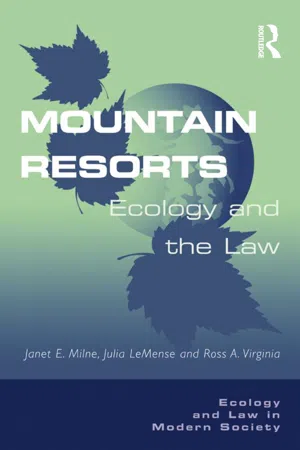
- 490 pages
- English
- ePUB (mobile friendly)
- Available on iOS & Android
About This Book
Mountains are the home of significant ecological resources - wildlife habitat, higher elevation plant systems, steep slopes, delicate soils and water systems. These resources are subject to very visible and growing pressures, most of which are caused by the unique features of mountains. Using as case studies four mountain resorts in the US and Canada, this book analyzes the extent to which the law protects the ecological systems of mountains from the adverse impacts associated with the development, operation and expansion of resorts. In order to examine these issues, Mountain Resorts takes an interdisciplinary approach, with contributions from ecologists and lawyers who focus on ski-related activities, increasing four-season use of the mountains and expanding residential, commercial and recreational development at the mountains' base. Its analysis of an array of US and Canadian federal, state and local laws provides a multifaceted exploration of the intersection of ecology and the law at mountain resorts.
Frequently asked questions
Information
Chapter 1 The Landscape of This Book
A Bird's Eye View of the Landscape of This Book
Who:A diverse cast of resort operators, recreational users, local residents, environmental organizations, ecologists, lawyers, and governments at the local, state or provincial, and federal levels.What:Mountain resorts in their ecosystems.Why:A chance to determine whether we take an ecosystem perspective in evaluating and regulating human impacts on mountains, moving beyond the traditional approach to environmental protection.Where:Four mountain resorts in northeastern United States and southeastern Canada that serve as case studies.When:Looking at the state of science and the law now and possibilities for the future.
Mountain Resorts
Table of contents
- Cover Page
- Half Title Page
- Series Page
- Title Page
- Copyright Page
- Contents
- List of Figures
- List of Tables
- List of Contributors
- Preface
- Acknowledgements
- List of Abbreviations
- 1 The Landscape of This Book
- Part I The Mountain Ecosystem
- Part II Loon Mountain, New Hampshire United States Federal Law and Mountain Resort Development in the National Forest
- Part III Whiteface Mountain Ski Center, New York Olympic Legacies and Adirondack Park Plans
- Part IV Killington Resort, Vermont Can a Mountain Ecosystem be Protected When the Law Protects its Parts? The Case of Act 250 and Killington Resort
- Part V Mont Tremblant, Quebec Canadian Law and the Ecological Footprint of a Four-Season Resort
- Part VI A Vision for the Mountains
- Index